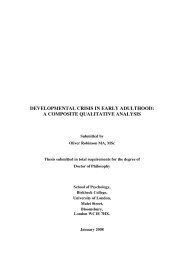student handbook: general information 2010-2011 - University of ...
student handbook: general information 2010-2011 - University of ...
student handbook: general information 2010-2011 - University of ...
Create successful ePaper yourself
Turn your PDF publications into a flip-book with our unique Google optimized e-Paper software.
12.1 Academic dishonesty<br />
In <strong>general</strong>, the School would want to encourage collaborative work with other <strong>student</strong>s<br />
and wide reference to other work - published and unpublished - in your studies. It is<br />
important to distinguish these activities from cheating plagiarism.<br />
There are various forms <strong>of</strong> academic dishonesty but in the <strong>student</strong> context it means<br />
cheating in examinations or presenting work for assessment which is not their own.<br />
Plagiarism as a form <strong>of</strong> cheating takes place when a <strong>student</strong> takes or copies<br />
<strong>information</strong>, data or results from an unacknowledged source, without quotation marks<br />
or any indication that the presenter is not the original author. If carried out knowingly,<br />
cheating and plagiarism have the objective <strong>of</strong> deceiving examiners and this threatens<br />
the integrity <strong>of</strong> the assessment procedures and the value <strong>of</strong> your awards. It is seeking<br />
to gain an unfair advantage over other <strong>student</strong>s.<br />
Warning<br />
Students are warned that all forms <strong>of</strong> cheating, including plagiarism, are totally<br />
unacceptable and any <strong>student</strong> discovered cheating or plagiarising is seen as having<br />
committed an <strong>of</strong>fence and will face serious consequences.<br />
A <strong>student</strong> who is thought to have attempted to gain an unfair advantage in an<br />
examination or other assessment may be deemed to have committed an <strong>of</strong>fence. There<br />
are <strong>University</strong>-wide regulations which are followed by staff where there are good<br />
grounds to suppose that an <strong>of</strong>fence has taken place. The procedure for investigating a<br />
suspected <strong>of</strong>fence and the range <strong>of</strong> penalties that can be imposed is outlined in the<br />
advice leaflets <strong>of</strong> The Office <strong>of</strong> Student Affairs<br />
12.2 Suspected plagiarism and cheating – definitions<br />
Plagiarism includes, but is not limited to:<br />
• Using published work without referencing (the most common);<br />
• Presenting group work as one’s own individual work without<br />
acknowledgement <strong>of</strong> other’s contribution;<br />
• Copying coursework essays;<br />
• Collaborating when the work is supposed to be individual;<br />
• Taking a computer file / program from another <strong>student</strong>;<br />
• Submitting the work <strong>of</strong> another person;<br />
• Copying someone else’s design without acknowledgement;<br />
• Using someone else’s design or visual material without acknowledgement;<br />
• The use <strong>of</strong> unacknowledged material published on the web;<br />
• Purchase <strong>of</strong> model assignments from whatever source.<br />
Similarly, cheating includes:<br />
• Bringing unauthorised material into an examination;<br />
• Including material programmed into a calculator;<br />
• Communicating with other <strong>student</strong>s in an examination;<br />
• Obtaining a copy <strong>of</strong> the examination paper in advance;<br />
• Persuading another person to sit the examination;<br />
30
















